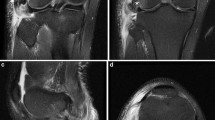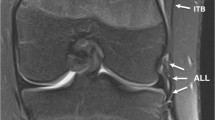Abstract
Objective
To assess MRI abnormalities of the medial patellofemoral ligament (MPFL) in patients with clinically and MRI-proven superficial medial collateral ligament (sMCL) injuries and determine the clinical significance.
Materials and methods
High-field strength knee MRI examinations were selected which demonstrated sMCL injuries. These cases were retrospectively reviewed for the presence, location, and severity of MPFL abnormality. The MPFL was divided into a more superior transverse component arising from a femoral attachment (tMPFL), and a broader more inferior oblique decussation component (odMPFL) arising from the anterior margin of the upper sMCL. Chart review was performed to determine the clinical relevance of any MPFL findings.
Results
One hundred patients with MCL injury were identified. These included 37 grade I sprains, 33 partial tears, 20 high-grade partial tears, and 10 full thickness tears. Abnormal edema was present at the femoral attachment of the tMPFL in 83%. The odMPFL was abnormal in 90%, most commonly involving the femoral third. No patients had imaging evidence of concurrent lateral patellar dislocation on the initial MRI study. No patients had documented patellofemoral instability at the time of original injury or upon follow-up. No patients required MPFL reconstruction.
Conclusion
The MRI appearance of the MPFL is abnormal in the majority of patients with clinically and MRI-documented sMCL sprains and tears. These cases had no evidence of concurrent lateral patellar dislocation on the initial MRI and did not develop patellar instability symptoms.








Similar content being viewed by others
Abbreviations
- AMT:
-
Adductor magnus tendon
- AT:
-
Adductor tubercle
- dMCL:
-
Deep medial collateral ligament
- fsT2W:
-
Fat suppressed T2 weighted
- MCL:
-
Medial collateral ligament
- MPFL:
-
Medial patellofemoral ligament
- odMPFL:
-
Oblique decussation component of the MPFL
- PDW:
-
Proton density weighted
- sMCL:
-
Superficial medial collateral ligament
- tMPFL:
-
Transverse component of the upper MPFL
References
Grood ES, Noyes FR, Butler DL, Suntay WJ. Ligamentous and capsular restraints preventing straight medial and lateral laxity in intact human cadaver knees. J Bone Joint Surg Am. 1981;63(8):1257–69.
Lind M, Jakobsen BW, Lund B, Hansen MS, Abdallah O, Christiansen SE. Anatomical reconstruction of the medial collateral ligament and posteromedial corner of the knee in patients with chronic medial collateral ligament instability. Am J Sports Med. 2009;37(6):1116–22.
Phisitkul P, James SL, Wolf BR, Amendola A. MCL injuries of the knee: current concepts review. Iowa Orthop J. 2006;26:77–90.
Wijdicks CA, Griffith CJ, Johansen S, Engebretsen L, LaPrade RF. Injuries to the medial collateral ligament and associated medial structures of the knee. J Bone Joint Surg Am. 2010;92(5):1266–80.
Naraghi AM, White LM. Imaging of athletic injuries of knee ligaments and menisci: sports imaging series. Radiology. 2016;281(1):23–40.
De Maeseneer M, Van Roy F, Lenchik L, Barbaix E, De Ridder F, Osteaux M (2000) Three layers of the medial capsular and supporting structures of the knee: MR imaging-anatomic correlation. Radiographics 20 Spec No:S83–89
Warren LF, Marshall JL. The supporting structures and layers on the medial side of the knee: an anatomical analysis. J Bone Joint Surg Am. 1979;61(1):56–62.
Thawait SK, Soldatos T, Thawait GK, Cosgarea AJ, Carrino JA, Chhabra A. High resolution magnetic resonance imaging of the patellar retinaculum: normal anatomy, common injury patterns, and pathologies. Skeletal Radiol. 2012;41(2):137–48.
Amis AA, Firer P, Mountney J, Senavongse W, Thomas NP. Anatomy and biomechanics of the medial patellofemoral ligament. Knee. 2003;10(3):215–20.
Tuxoe JI, Teir M, Winge S, Nielsen PL. The medial patellofemoral ligament: a dissection study. Knee Surg Sports Traumatol Arthrosc. 2002;10(3):138–40.
Baldwin JL. The anatomy of the medial patellofemoral ligament. Am J Sports Med. 2009;37(12):2355–61.
LaPrade RF, Engebretsen AH, Ly TV, Johansen S, Wentorf FA, Engebretsen L. The anatomy of the medial part of the knee. J Bone Joint Surg Am. 2007;89(9):2000–10.
Schweitzer ME, Tran D, Deely DM, Hume EL. Medial collateral ligament injuries: evaluation of multiple signs, prevalence and location of associated bone bruises, and assessment with MR imaging. Radiology. 1995;194(3):825–9.
Quinlan JF, Farrelly C, Kelly G, Eustace S. Co-existent medial collateral ligament injury seen following transient patellar dislocation: observations at magnetic resonance imaging. Br J Sports Med. 2010;44(6):411–4.
Allen BJ, Krych AJ, Engasser W, Levy BA, Stuart MJ, Collins MS, et al. Medial patellofemoral ligament tears in the setting of multiligament knee injuries rarely cause patellar instability. Am J Sports Med. 2015;43(6):1386–90.
Balcarek P, Walde TA, Frosch S, Schuttrumpf JP, Wachowski MM, Sturmer KM. MRI but not arthroscopy accurately diagnoses femoral MPFL injury in first-time patellar dislocations. Knee Surg Sports Traumatol Arthrosc. 2012;20(8):1575–80.
Stefancin JJ, Parker RD. First-time traumatic patellar dislocation: a systematic review. Clin Orthop Relat Res. 2007;455:93–101.
Reagan J, Kullar R, Burks R. MPFL reconstruction: technique and results. Clin Sports Med. 2014;33(3):501–16.
Acknowledgements
The authors acknowledge Michael J. Stuart MD, Department of Orthopedics and Sports Medicine, for critical review of the manuscript, and Sonia Watson PhD for assistance in preparation of the manuscript.
Author information
Authors and Affiliations
Corresponding author
Ethics declarations
Ethics approval
All procedures in studies involving human participants were in accordance with ethical standards of the institutional and/or national research committee and with the 1964 Helsinki declaration and its later amendments or comparable ethical standards.
Informed consent
Approval from the Institutional Review Board was obtained and in keeping with the policies for a retrospective review; informed consent was not required.
Conflict of interest
The authors declare no competing interests.
Additional information
Publisher's Note
Springer Nature remains neutral with regard to jurisdictional claims in published maps and institutional affiliations.
Rights and permissions
About this article
Cite this article
Collins, M.S., Tiegs-Heiden, C.A., Frick, M.A. et al. Medial patellofemoral ligament MRI abnormalities in the setting of MCL injuries: are they clinically relevant?. Skeletal Radiol 51, 1381–1389 (2022). https://doi.org/10.1007/s00256-021-03969-4
Received:
Revised:
Accepted:
Published:
Issue Date:
DOI: https://doi.org/10.1007/s00256-021-03969-4




